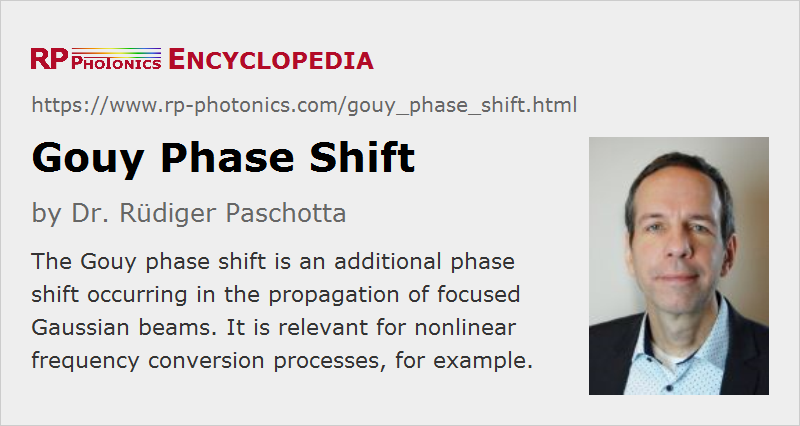Gouy Phase Shift
Definition: an additional phase shift occurring in the propagation of focused Gaussian beams
More general term: optical phase shift
German: Gouy-Phasenverschiebung
Author: Dr. Rüdiger Paschotta
Cite the article using its DOI: https://doi.org/10.61835/kmi
Get citation code: Endnote (RIS) BibTex plain textHTML
(Widespread wrong spelling: “Guoy phase shift”)
A plane wave propagating in <$z$> direction acquires an phase shift <$k z$> according to its wavenumber <$k$>. This rule does not precisely hold for light beams, being confined in the transverse directions: Here, the phase evolution somewhat deviates from that of a plane wave, and the phase advancement per unit length is not constant, particularly around the focus.
In particular, for a Gaussian beam the phase shift deviates from that of a plane wave by the so-called Gouy phase shift [1]:
$${\varphi _{\rm{G}}}(z) = - \arctan \frac{z}{{{z_{\rm{R}}}}}$$where <$z_\textrm{R}$> is the Rayleigh length and <$z$> = 0 corresponds to the position of the beam waist. As can be seen in Figure 1, that term varies substantially around the beam focus, and not much in regions far from the focus.
In the literature, the formula is also found with a positive sign, but in any case the phase shift of a Gaussian beam is reduced (rather than increased) with respect to that of a plane wave. This results in a slightly increased distance between wavefronts, compared with the wavelength as defined for a plane wave of the same frequency. A consequence is that the phase fronts have to propagate somewhat faster, leading to an effectively increased local phase velocity. For propagation in vacuum, that amounts to a kind of superluminal transmission.
Overall, the Gouy phase shift of a Gaussian beam for going through a focus (from the far field to the far field on the other side of the focus) is <$-\pi$>, as that phase shift changes from the asymptotic value <$+\pi / 2$> to <$-\pi / 2$>.

The positions at plus and minus the Rayleigh length are marked.
It is actually not surprising that the phase shift of a Gaussian beam is not exactly the same as for a plane wave. A Gaussian beam can be considered as a superposition of plane waves with different propagation directions. Those plane wave components with propagation directions different from the beam axis experience smaller phase shifts in <$z$> direction; the overall phase shift arises from a superposition of all these components.
A similar kind of reasoning is based on the observation that the transverse confinement causes some spread of transverse wave vector components, thus a corresponding reduction in the longitudinal wave vector component, which finally leads to a reduction of the phase shift [5].
For higher-order transverse modes, there is a similar but stronger phase shift. For Hermite–Gaussian (TEMnm) modes, for example, it is stronger by the factor <$1 + n + m$>, while for Laguerre–Gaussian modes that factor is <$1 + |m| + 2 p$>, where <$p$> is the radial index and <$m$> the azimuthal index. This change causes the resonance frequencies of higher-order modes in optical resonators to be somewhat higher. By lifting the frequency degeneracy of resonator modes, the Gouy phase shift also has an important impact on the beam quality achieved in a laser resonator under the influence of optical aberrations [6].
More to Learn
Encyclopedia articles:
Blog articles:
Bibliography
| [1] | L. G. Gouy, “Sur une propriete nouvelle des ondes lumineuses”, C. R. Acad. Sci. Paris 110, 1251 (1890) |
| [2] | A. Rubinowicz, “On the anomalous propagation of phase in the focus”, Phys. Rev. 54 (11), 931 (1938); https://doi.org/10.1103/PhysRev.54.931 |
| [3] | L. G. Gouy, “Sur la propagation anomale des ondes”, Compt. Rendue Acad. Sci. Paris 111, 33 (1890) |
| [4] | R. W. Boyd, “Intuitive explanation of the phase anomaly of focused light beams”, J. Opt. Soc. Am. 70 (7), 877 (1980); https://doi.org/10.1364/JOSA.70.000877 |
| [5] | S. Feng and H. G. Winful, “Physical origin of the Gouy phase shift”, Opt. Lett. 26 (8), 485 (2001); https://doi.org/10.1364/OL.26.000485 |
| [6] | R. Paschotta, “Beam quality deterioration of lasers caused by intracavity beam distortions”, Opt. Express 14 (13), 6069 (2006); https://doi.org/10.1364/OE.14.006069 (explaining the important impact of the Gouy phase on the laser beam quality) |
| [7] | M. Hiekkamäki et al., “Observation of the quantum Gouy phase”, Nature Photonics 16, 828–833 (2022); https://doi.org/10.1038/s41566-022-01077-w |
Questions and Comments from Users
Here you can submit questions and comments. As far as they get accepted by the author, they will appear above this paragraph together with the author’s answer. The author will decide on acceptance based on certain criteria. Essentially, the issue must be of sufficiently broad interest.
Please do not enter personal data here; we would otherwise delete it soon. (See also our privacy declaration.) If you wish to receive personal feedback or consultancy from the author, please contact him, e.g. via e-mail.
By submitting the information, you give your consent to the potential publication of your inputs on our website according to our rules. (If you later retract your consent, we will delete those inputs.) As your inputs are first reviewed by the author, they may be published with some delay.

 general optics
general optics
Share this with your friends and colleagues, e.g. via social media:
These sharing buttons are implemented in a privacy-friendly way!